The Industrial Workhorse: How Hydrogenated RBD Palm Stearin is Driving Efficiency in Plastics and Rubber This Quarter

Table of Content
- Engineering a Competitive Edge
- The Bottom-Line Impact of a Superior Additive
In today's competitive industrial landscape, manufacturing efficiency is the ultimate currency. This September, the data points to a growing reliance on Hydrogenated RBD Palm Stearin as a mission-critical processing additive in the plastics and rubber sectors. In this high-stakes environment, the reliability of your raw material supply chain can make or break production targets. That's why leading manufacturers partner with Tradeasia International to source performance-critical additives that guarantee consistency and drive operational excellence.
Engineering a Competitive Edge
The value of Hydrogenated RBD Palm Stearin is measured in tangible performance gains. Demand for this industrial workhorse is closely tracking the 10% quarter-over-quarter growth in global PVC pipe and fitting manufacturing, where it acts as a powerful external lubricant. Industrial case studies demonstrate that its inclusion in PVC formulations can reduce friction and improve polymer flow, cutting processing cycle times by an impressive 8%. Delivering these small but powerful advantages through smarter ingredient sourcing is the cornerstone of a winning procurement strategy in a market where every second counts.
The Bottom-Line Impact of a Superior Additive
This efficiency translates directly to the bottom line. By optimizing the manufacturing process, stearin not only accelerates output but can also reduce energy consumption by up to 5%. The automotive sector, a major consumer, sees similar benefits in tire production, where stearin is used to aid the dispersion of fillers to enhance durability and strength. As technical briefs on oleochemicalsasia.com confirm, its role is crucial for meeting stringent safety standards. With over 2.2 million tons of stearin-derived fatty acids used annually in industrial applications, it has proven itself to be an essential catalyst for achieving greater efficiency and a stronger financial performance.
Sources:
-
Plastics Industry Association: Plastics Market Watch: Slower Growth for Plastics in an Uncertain Economy
-
MarketsandMarkets: Stearic Acid Market worth $11.1 billion by 2027
-
Oleochemicals Asia: Stearic Acid: The Foundation for Diverse Applications

Leave a Comment